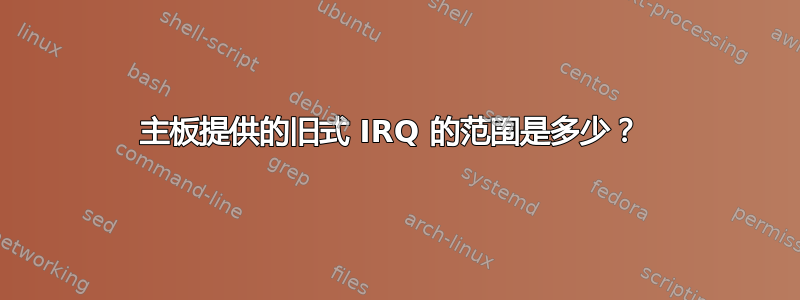
主板提供的旧式 IRQ 的范围是多少?介于多少之间?对我来说,这是一次艰难的审查。
1 至 15
0 至 14
0 至 15
1 至 8
答案1
来源解决硬件冲突
检查冲突
为了明确地确定非 PnP 设备上正在使用的 IRQ、基地址和 DMA 通道,您需要知道卡的跳线/DIP 设置。
这包括所有 ISA 卡以及主板上的任何非 PnP 设备。IRQ 冲突似乎是冲突的最大原因。基地址和 DMA 冲突并不常见(但如果您的系统中有 2 个或更多相同类型的卡,例如 2 个 MIDI/音频卡,则基地址和 DMA 冲突的可能性会大大增加,因为许多相同类型卡的制造商遵循彼此的 IRQ/地址/DMA 设置“标准”。例如,大多数 MIDI 卡使用 Roland MPU-401 标准 I/O 地址 330)。
以下是我发现的最常见 IRQ 分配的列表。我认为可以相当安全地假设这些,但除了标准设备(即时钟、键盘、串行 + 并行端口、HD 和软盘控制器、数学芯片)之外,请检查所有其他设备:
IRQ # 0 System timer 1 Keyboard 2 Cascade for second interrupt chip 3 Serial (COM) port 2 (often a modem is attached to this) 4 Serial (COM) port 1 (usually a serial mouse is attached to this) 5 Parallel port 2 (not often used) 6 Floppy controller 7 Parallel port 1 (usually a printer is attached to this) 8 Realtime clock 9 free (but some video cards may use this for EGA emulation) 10 free 11 free 12 free 13 Math chip 14 HD (IDE) controller 15 Second IDE controller (usually a CD-ROM is attached to this. This second IDE controller may even be on your sound card, such as an SB card)通常,声卡设置为使用 IRQ 5。这通常是一个不错的选择。通常,IRQ 10、11 和 12 可以安全使用(假设其他 ISA 卡未使用此类 IRQ)。如果卡具有 MPU-401 兼容 MIDI 端口,它通常使用 I/O 地址 330 和 331(十六进制)。MIDI 端口还可以使用另一个 IRQ,例如 9,与卡的数字音频部分使用的 IRQ 分开。
*主板提供的旧式 IRQ 的范围是多少?介于什么和什么之间?
0 至 15 之间


